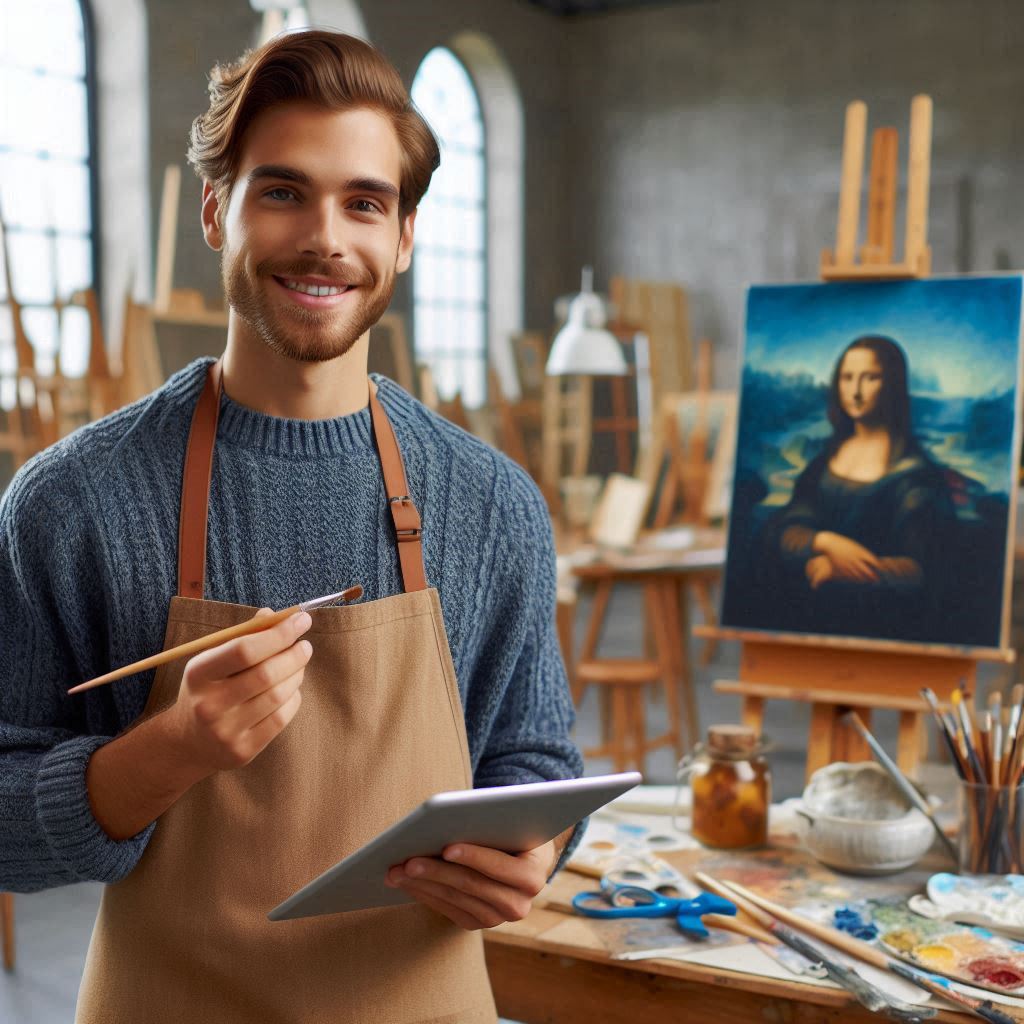Introduction
Art conservators play a vital role in preserving and maintaining the artworks showcased in museums.
They ensure the longevity and integrity of valuable pieces.
Art conservators are responsible for protecting and preserving cultural heritage for future generations to appreciate and learn from.
Art conservation is the practice of restoring and preserving artwork using various techniques to prevent deterioration and maintain its original state.
- Conservators assess, document, clean, repair, and restore artworks while adhering to ethical guidelines to ensure authenticity and historical accuracy.
- Conservators use scientific methods such as x-rays, infrared photography, and chemical analysis to examine materials and ensure appropriate conservation strategies.
- Conservators often work closely with artists to understand their techniques and materials, informing conservation decisions and honoring the artist’s intentions.
- Conservators also focus on preventive conservation by controlling environmental factors like temperature, humidity, and light to safeguard artworks from degradation.
- Conservators educate the public about conservation practices, raising awareness and appreciation for the importance of preserving cultural heritage for future generations.
Importance of art conservation in museums
Art conservators play a crucial role in ensuring the preservation and maintenance of artworks in museums.
Let’s explore the importance of art conservation in museums:
Preserving Cultural Heritage and Historical Artifacts
One of the primary responsibilities of art conservators is to safeguard cultural heritage and historical artifacts for future generations.
By employing various techniques and methods, conservators help prevent irreversible damage to artworks, ensuring that they remain intact and authentic over time.
Preventing Deterioration and Damage to Artwork
Artworks are susceptible to deterioration due to various factors such as light exposure, temperature fluctuations, humidity, pollution, and handling.
Art conservators work tirelessly to mitigate these risks by implementing preventive conservation measures and conducting regular assessments to identify potential issues before they escalate.
Ensuring Longevity and Accessibility of Art for Future Generations
By preserving and maintaining artworks, art conservators ensure that these cultural treasures remain accessible to future generations.
Through careful conservation practices, conservators prolong the lifespan of artworks, allowing them to be enjoyed and studied by art enthusiasts, scholars, and the general public for years to come.
Enhancing Public Appreciation and Understanding of Art
Art conservation plays a vital role in enhancing public appreciation and understanding of art.
By restoring and conserving artworks, conservators provide opportunities for viewers to engage with the rich history and craftsmanship embodied in each piece.
Through educational programs and interactive exhibits, museums can educate visitors about the significance of art conservation and the importance of preserving cultural heritage.
In essence, art conservators are integral to the sustainability and vitality of museums.
Their expertise and dedication ensure that our cultural heritage and artistic treasures are safeguarded for future generations to cherish and admire.
Read: Famous Artworks Saved by Conservation Efforts
Responsibilities of art conservators
Art conservators play a crucial role in museums by ensuring the preservation and longevity of artwork.
Their responsibilities encompass a wide range of tasks that require specialized knowledge and skills.
Transform Your Career Today
Unlock a personalized career strategy that drives real results. Get tailored advice and a roadmap designed just for you.
Start NowLet’s delve deeper into the responsibilities of art conservators and understand the importance of their work.
Examination and Assessment of Artwork
One of the primary responsibilities of art conservators is to examine and assess the condition of artwork.
This involves a detailed inspection to identify any damage, deterioration, or potential risks to the artwork.
Conservators use various tools and techniques to assess the structural integrity, materials, and overall health of the artwork.
By thoroughly examining the artwork, conservators can determine the appropriate conservation treatments needed to preserve and restore it.
Development of Conservation Treatment Plans
Based on their examination and assessment of artwork, conservators develop detailed conservation treatment plans.
These plans outline the specific actions and techniques required to stabilize, clean, repair, and restore the artwork.
Conservation treatment plans are tailored to the individual needs of each piece, taking into account factors such as the artist’s intent, historical significance, and condition of the artwork.
Conservators must carefully plan and document every step of the conservation process to ensure the artwork is preserved according to professional standards.
Cleaning, Repairing, and Restoring Artwork
Conservators are skilled in a variety of techniques for cleaning, repairing, and restoring artwork.
Cleaning involves the removal of dirt, grime, and other surface contaminants without causing damage to the artwork.
Repairing may include consolidation of flaking paint, filling in losses, or reattaching detached components.
Restoration aims to recreate missing or damaged areas of the artwork while maintaining its integrity and authenticity.
These delicate procedures require precision, patience, and expertise to ensure that the artwork is preserved and enhanced for future generations.
Documentation of Conservation Processes and Materials Used
Documentation is a critical aspect of the conservation process, and conservators meticulously record all actions taken and materials used during treatment.
Detailed documentation serves as a historical record of the artwork’s conservation history and provides valuable information for future research and reference.
Conservators document their examinations, assessments, treatment plans, procedures, and outcomes to create a comprehensive record of the conservation process.
This documentation is essential for transparency, accountability, and ensuring the long-term preservation of the artwork.
In fact, art conservators play a vital role in museums by safeguarding the cultural heritage and artistic legacy preserved in their collections.
Through their expertise, dedication, and meticulous attention to detail, conservators ensure that artworks are protected, restored, and displayed for the enjoyment and education of present and future generations.
Transform Your Career Today
Unlock a personalized career strategy that drives real results. Get tailored advice and a roadmap designed just for you.
Start NowThe responsibilities of art conservators encompass a wide range of tasks that require specialized knowledge, skills, and a profound commitment to preserving our artistic heritage.
Read: Innovative Methods in Modern Art Conservation

Specialized skills and training required for art conservation
Art conservators play a crucial role in museums by preserving and restoring artworks for future generations to appreciate.
These professionals require a unique set of skills and training to carry out their work effectively.
Knowledge of art history and materials
Art conservators must have a deep understanding of art history to contextualize the artworks they work on.
They need to know the techniques and materials used by artists throughout history to make informed decisions during the conservation process.
Understanding of scientific principles and methods
Conservators often use scientific analysis to examine artworks and determine the best conservation approach.
They may utilize techniques such as X-ray fluorescence, infrared reflectography, and microscopy to identify materials and understand the condition of the artwork.
Fine motor skills for delicate restoration work
Conservators must possess excellent manual dexterity to handle fragile and intricate artworks.
They use specialized tools and techniques to perform precise restoration work without causing damage to the original piece.
Training in ethical standards and conservation practices
Art conservators adhere to strict ethical guidelines to ensure the integrity of the artworks they work on.
They must follow established conservation practices to preserve the authenticity and value of the pieces in their care.
In short, art conservators play a vital role in museums by ensuring the longevity of artworks for future generations.
Their specialized skills and training enable them to preserve and restore precious cultural heritage with precision and care.
Read: Makeup Artist Certification: Is It Worth It?
Challenges Faced by Art Conservators
Art conservators play a crucial role in museums by preserving and protecting valuable artworks for future generations.
However, they face various challenges in their work that can make their job both rewarding and daunting.
Some of the key challenges include:
Balancing Preservation with Aesthetic Considerations
One of the primary challenges for art conservators is striking the right balance between preserving the original integrity of the artwork and making it aesthetically pleasing for display.
They must ensure that any conservation treatments do not compromise the artistic intent or historical significance of the piece.
Transform Your Career Today
Unlock a personalized career strategy that drives real results. Get tailored advice and a roadmap designed just for you.
Start NowDealing with Limited Resources and Funding
Art conservation is a costly and time-consuming process that requires specialized equipment, materials, and expertise.
Many museums and cultural institutions struggle with limited resources and funding, which can make it challenging for conservators to carry out their work effectively.
Addressing Controversial Issues such as Repatriation and Authenticity
Art conservators often find themselves in the midst of controversial debates regarding the repatriation of stolen or looted artifacts and the authenticity of certain artworks.
These ethical dilemmas can pose significant challenges for conservators who must navigate complex legal and cultural issues.
Keeping Up with Advancements in Conservation Technology
The field of art conservation is constantly evolving, with new techniques and technologies emerging to improve the preservation and restoration of artworks.
Art conservators must stay up to date with these advancements to ensure they are using the most effective methods and tools available.
In general, art conservators face a myriad of challenges in their important work of preserving and protecting cultural heritage.
Despite these obstacles, their dedication and expertise are essential in ensuring that valuable artworks are safeguarded for future generations to enjoy.
Read: Professional Organizations for Art Conservators
Collaboration with other museum professionals
Working closely with curators, registrars, and educators
Conservators play a crucial role in museums, not only in the preservation of artworks but also in collaborating with other museum professionals to ensure the overall success of the institution.
One of the key aspects of their work is their collaboration with curators, registrars, and educators.
Working closely with curators allows conservators to gain a deeper understanding of the artworks in the collection.
This collaboration is essential in determining the best conservation practices for each piece, taking into consideration the historical context and significance of the artwork.
In addition to working with curators, conservators also collaborate with registrars to document and track the condition of artworks.
By maintaining detailed records of the conservation treatments, conservators help registrars in managing the collection and ensuring the proper care and handling of the artworks.
Furthermore, conservators often work hand in hand with educators to develop programs and exhibitions that engage the public in the conservation process.
By sharing their expertise and knowledge, conservators play a vital role in educating visitors about the importance of preserving cultural heritage.
Participating in interdisciplinary projects and research
Participating in interdisciplinary projects and research is another crucial aspect of collaboration for conservators in museums.
By working with scientists, art historians, and other experts, conservators can explore new techniques and technologies that can further advance conservation practices.
Sharing expertise and knowledge to enhance museum practices
By sharing their expertise and knowledge with their colleagues, conservators contribute to the development of best practices in conservation.
Transform Your Career Today
Unlock a personalized career strategy that drives real results. Get tailored advice and a roadmap designed just for you.
Start NowThis collaborative approach not only benefits the museum’s collection but also enhances the overall museum experience for visitors.
The synergy created by working together with other museum professionals ultimately elevates the impact and importance of art conservation in museums.
Impact of art conservation on museum visitors
Providing educational programs and workshops on conservation
Art conservation plays a crucial role in enhancing the museum experience.
One significant impact is through educational programs and workshops.
Museums often host events that educate visitors about the art conservation process.
These programs provide insight into the techniques used to preserve artworks.
They also offer hands-on opportunities for visitors to engage with the conservation process.
By participating in these activities, the public gains a deeper understanding of the challenges involved in preserving art.
Engaging the public in the conservation process
Engaging the public in the conservation process further enriches the museum experience.
Interactive exhibits and live demonstrations allow visitors to witness conservation work firsthand.
This involvement helps demystify the process and fosters a greater appreciation for the skill and care involved.
When visitors see conservators at work, they can connect more personally with the art and its history.
This engagement creates a more immersive and memorable museum visit.
Increasing awareness and appreciation of conservation efforts
Increasing awareness and appreciation of conservation efforts is another vital impact.
Museums use various methods to highlight the importance of art preservation.
Informative displays, labels, and multimedia presentations often explain the significance of conservation.
These efforts help visitors recognize the value of preserving cultural heritage.
Understanding the behind-the-scenes work involved in conservation fosters respect for both the art and the professionals who care for it.
Inspiring future generations to pursue careers in art conservation
Lastly, inspiring future generations to pursue careers in art conservation is a long-term benefit.
Educational programs and public engagement often spark interest in young visitors.
Transform Your Career Today
Unlock a personalized career strategy that drives real results. Get tailored advice and a roadmap designed just for you.
Start NowBy showcasing the rewarding aspects of conservation work, museums encourage students to consider this career path.
This inspiration helps ensure the continuation of conservation practices and the preservation of art for future generations.
Art conservation not only protects artworks but also cultivates future stewards of cultural heritage.
Gain More Insights: How to Become a Successful Lighting Designer
Explore Further: Typography in Mobile App Design: Best Practices
Conclusion
Art conservators play a vital role in preserving and maintaining the cultural heritage housed within museums, ensuring that future generations can appreciate these works of art.
It is essential to highlight the collaborative efforts involved in art conservation, as conservators work closely with curators, researchers, scientists, and other professionals to protect and restore art pieces.
To safeguard our artistic heritage, it is crucial for cultural institutions, patrons, and the public to recognize the importance of art conservation and provide the necessary resources and advocacy to sustain these efforts.
[E-Books for Sale]
The Big Book of 500 High-Paying Jobs in America: Unlock Your Earning Potential
$19.99 • 500 High-Paying Jobs • 330 pages
Explore 500 high-paying jobs in America and learn how to boost your career, earn more, and achieve success!
See All 500 High-Paying Jobs of this E-Book
1001 Professions Without a Degree: High-Paying American Jobs You Can Start Now
$19.99 • 1001 Professions Without a Degree • 174 pages
Discover 1001 high-paying jobs without a degree! Unlock career tips, skills, and success strategies for just $19.99!




